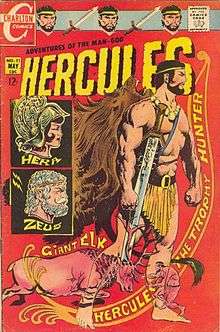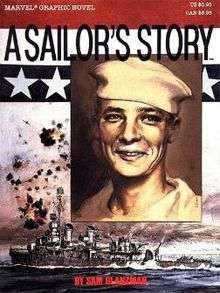Sam Glanzman
| Sam Glanzman | |
|---|---|
| Born |
Samuel J. Glanzman December 5, 1924 |
| Nationality | American |
| Area(s) | Artist |
| Pseudonym(s) |
Sam Glanz SJG Sam Decker |
Notable works |
Hercules "The Lonely War of Willy Schultz" |
Sam J. Glanzman (born December 5, 1924)[1][2] is an American comic-book artist, best known for his Charlton Comics series Hercules, about the mythological Greek demigod; his biographical war stories about his service aboard the U.S.S. Stevens for DC Comics and Marvel Comics; and the Charlton Comics Fightin' Army feature "The Lonely War of Willy Schultz", a Vietnam War-era serial about a German-American U.S. Army captain during World War II.
Biography
Early life and career
Sam Glanzman, whose brothers are D.C. (Davis Charles) Glanzman, a comic-book artist,[3] and Louis "Lew" Glanzman,[4] who began in comics before becoming a fine art painter,[5] ended his formal education after grade school.[6] Glanzman entered the comics industry in late 1939, during the period historians and fans call the Golden Age of comic books, at Funnies, Inc.,[5] one of the early "packagers" that supplied comics to publishers then entering the fledgling medium. There, for Centaur Publications, he wrote two-page text stories with incidental art for Amazing-Man Comics. Later for Harvey Comics, he created Fly-Man in the superhero anthology Spitfire Comics #1 (August 1941), writing and drawing the feature for at least two issues. He also contributed to Harvey's All-New Short Story Comics (where he published his first recorded war story); Champ Comics (doing the superhero the Human Meteor); and the radio program tie-in series Green Hornet Comics through 1943.[7]
Following his World War II service in the U.S. Navy, during which he was stationed on the destroyer U.S.S. Stevens, he was discharged in 1946.[5] Glanzman eschewed comics ("I was getting $7.50 a page for [Fly-Man], pencils, inks, story, and coloring. ... I figured, 'Hell, that's not much money.'"[5]) and began a peripatetic career doing manual labor in cabinet shops, lumber mills, and boat yards. After marrying in the 1950s, he worked at Republic Aviation in Farmingdale, New York, installing machine guns on military jets.[5] During this time, he lived in Rockaway, Queens, New York City, and in the Long Island towns of Valley Stream and Massapequa Park.[5]
Seeking to return to art, Glanzman had done some work for the Eastern Color series Heroic Comics and New Heroic Comics in 1950, and found better-paying assignments doing children's-book illustration. He additionally did possibly uncredited work for his brother, Louis Glanzman, on a hardcover-book series for children about aircraft.[5] Work was not steady, however, and Glanzman returned to Republic.[5]
Charlton Comics

In 1958, Glanzman began working with Pat Masulli, the executive editor of Charlton Comics, a low-paying publishing company. He specialized in stories for the war titles Attack, Battlefield Action, Fightin' Air Force, Fightin' Marines, Submarine Attack, U.S. Air Force Comics, and War at Sea, producing a large amount of authentically detailed work through mid-1961,[7] when he switched to Dell Comics. There he draw for the anthology Combat, drew the movie adaptation Voyage to the Bottom of the Sea (and the similar, though unrelated, four-issue Voyage to the Deep), and a range of titles from lost-world adventure (Kona, Monarch of Monster Isle)[8] to heartwarming animal drama (Lad: A Dog).[7] He occasionally still moonlighted for Charlton, using the initials "SJG" for his work on the 1962 Marco Polo movie adaptation and elsewhere.[7]
Beginning mid-1964, Glanzman moved regularly between Charlton and Dell assignments, almost exclusively on war stories, but also on a Charlton Tarzan series.[7] Contrary to some sources, Glanzman denies co-creating the Charlton hardboiled detective character Sarge Steel. He stated in a 2009 interview that "The only thing I created was the "U.S.S. Stevens", "Attu" and A Sailor's Story."[9]
During this 1960s period fans and historians call the Silver Age of comic books, Glanzman, with writer Gill, created the Charlton mythological-adventure series Hercules: Adventures of the Man-God, which would run 13 issues (October 1967 – September 1969),[7] and showcase Glanzman's experimental side, where he might float Art Nouveau-bordered panels within action tableaux filled with Hieronymous Boschian nightmares.[10]
Also during this time he co-created, with writer Will Franz, "The Lonely War of Willy Schultz",[11] a departure from most other World War II features of this time, with a conflicted American soldier of German heritage caught between loyalties. During combat in the European Theater, U.S. Army captain Schultz is falsely accused and convicted of murder; he escapes and blends into the German Army while seeking a way to clear his name and retain his Allied allegiance. The feature, reprinted as late as 1999,[12] was serialized in Charlton's Fightin' Army #76–80, 82-92 (October 1967 – July 1968, November 1968 – July 1970).[7]
During the 1960s as well, Glanzman freelanced for Outdoor Life magazine.[3]
DC Comics
War-comic editor-artist Joe Kubert of DC Comics, one of the two industry leaders, brought Glanzman, a veteran in dual senses, to work on Our Army at War, Star Spangled War Stories, Weird War Tales and other combat titles including G.I. Combat, where for years he illustrated the feature "Haunted Tank". At DC, Glanzman began his series of biographical war stories about his service aboard the U.S.S. Stevens in Our Army at War #218 (April 1970).[13][14] Glanzman would also occasionally draw stories for DC's supernatural-mystery anthologies. He was one of the contributors to the debut issues of Ghosts[15] and Blitzkrieg.[16] By late 1979, with most of DC's war titles either canceled or converted to character series with established teams, Glanzman remained solely on G.I. Combat and began freelancing again for Charlton. Following his last "Haunted Tank" story, in G.I. Combat #288 (March 1987), Glanzman drew two more stories for DC a year later, in Sgt. Rock #420–421 (Feb.–April 1988). He would return to ink penciler Tim Truman on the Western miniseries Jonah Hex: Two Gun Mojo (September–December 1993), Jonah Hex: Riders of the Worm and Such (March–July 1995), and Jonah Hex: Shadows West (Feb.–April 1999) all written by Joe R. Lansdale.
Later career

Glanzman also contributed a handful of war stories to Marvel Comics from 1986–1989, in the black-and-white adventure magazine Savage Tales, the Marine Corps series Semper Fi, an issue of The 'Nam, and most notably A Sailor's Story / Marvel Graphic Novel #30 (March 1987), a 60-page true account, which he both wrote and drew, of his time on U.S.S. Stevens during World War II.[14] Unusually for Marvel's graphic novel line, it was released in hardcover rather than as a trade paperback. A trade paperback edition followed, together with a sequel, A Sailor's Story, Book Two: Winds, Dreams, and Dragons, which continued the story up to the end of the war.[7]
Other work in the 1990s included inking some issues of Turok Dinosaur Hunter for Acclaim Comics and Zorro for Topps Comics, and writing and drawing a serialized feature in Flashback Comics' Fantastic Worlds #1. His later work includes stories in two anthologies: Writing and drawing the 10-page, true-life story "On the Job: Cooks Tour," in the graphic-story trade paperback Streetwise (TwoMorrows Publishing, 2000, ISBN 1-893905-04-7), and the donated, four-page "There Were Tears in Her Eyes," in the squarebound benefit comic 9-11: The World's Finest Comic Book Writers & Artists Tell Stories to Remember, Volume Two (2002).[7]
From 1999–2001, the Avalon Communications imprint America's Comic Group / ACG (not to be confused with American Comics Group / AGC) reprinted copious amounts of Glanzman's Charlton Comics work in a number of mostly one-shot titles, including Hercules, Flyboys, Nam Tales, Star Combat Tales, Total War, and ACG Comics Presents Fire and Steel.[7]
In 2003, Glanzman began working on webcomics, writing and drawing the 19th century nautical adventure Apple Jack, and reteaming with his "Willy Schultz" writer, Will Franz, on the Roman centurion series The Eagle.[17] In 2012 and 2013, new "U.S.S. Stevens" stories by Glanzman appeared in the Joe Kubert Presents six-issue anthology limited series.[18] In 2015, Glanzman's "U.S.S. Stevens" stories and the A Sailor's Story graphic novels will be collected by Dover Publications.[19]
USS Stevens stories
Glanzman's U.S.S. Stevens stories for DC Comics appear in:[20]
- Our Army at War #220, 223, 225, 227, 230–232, 235 238, 240–242, 244–245, 247–248, 256–259, 261–262, 265–267, 275, 281–282, 284, 293, 298 (1970–1976)
- Our Fighting Forces 128, 132, 134, 136, 138-139, 140-141, 143 (1970–1972)
- Weird War Tales #4 (1972)
- G.I. Combat #152 (1972)
- Star Spangled War Stories #167, 171, 174 (1973)
- Sgt. Rock #308 (1977)
- Joe Kubert Presents #1–6 (2012–2013)
References
- ↑ "Sam Glanzman". Lambiek Comiclopedia. December 7, 2012. Archived from the original on February 2, 2015.
- ↑ Miller, John Jackson (June 10, 2005). "Comics Industry Birthdays". Comics Buyer's Guide. Iola, Wisconsin. Archived from the original on October 29, 2010. Retrieved December 12, 2010.
- 1 2 Glanzman interview (August 2000). "Glanzman's Derby Days". Comic Book Artist (9). Raleigh, North Carolina: TwoMorrows Publishing. p. 92.
- ↑ "Louis Glanzman". Lambiek Comiclopedia. December 7, 2012. Archived from the original on February 2, 2015.
- 1 2 3 4 5 6 7 8 Glanzman, Comic Book Artist, p. 90
- ↑ Glanzman, Comic Book Artist, p. 93
- 1 2 3 4 5 6 7 8 9 10 Sam Glanzman at the Grand Comics Database
- ↑ Markstein, Don (2010). "Kona, Monarch of Monster Isle". Don Markstein's Toonopedia. Archived from the original on October 25, 2011.
- ↑ Stroud, Bryan (June 14, 2009). "Sam Glanzman interview". The Silver Age Sage. Archived from the original on August 29, 2012.
- ↑ Glanzman, Comic Book Artist, illustration p. 91
- ↑ Glanzman, Comic Book Artist, pp. 91–92
- ↑ The Lonely War Of Willy Schultz #1-4 (May – November 1999), published by Avalon Communications / America's Comics Group
- ↑ McAvennie, Michael; Dolan, Hannah, ed. (2010). "1970s". DC Comics Year By Year A Visual Chronicle. London, United Kingdom: Dorling Kindersley. p. 139. ISBN 978-0-7566-6742-9.
It was Glanzman's semi-autobiographical tales in Our Army at War that brought a harrowing realism to World War II that few war comics have matched.
- 1 2 Markstein, Don (2010). "U.S.S. Stevens". Don Markstein's Toonopedia. Archived from the original on February 2, 2015.
- ↑ McAvennie "1970s" in Dolan, p. 147
- ↑ McAvennie "1970s" in Dolan, p. 171: "In February [1976], editor and cover artist Joe Kubert helmed Blitzkrieg #1, a unique anthology about World War II as seen through the eyes of the enemy. The first issue featured stories by writer Robert Kanigher, artist Ric Estrada, and storyteller Sam Glanzman."
- ↑ Comic Book Stories (webcomics site) at the Wayback Machine (archived October 12, 2006). Original site.
- ↑ Wunderlich, Chris (January 26, 2015). "BTFT: Joe Kubert and the Other Mr. T". ComicsAlliance. Archived from the original on February 3, 2015.
- ↑ Dueben, Alex (December 31, 2014). "Sam Glanzman Tells A Sailor's Story". Comic Book Resources. Archived from the original on February 3, 2015.
As writer and artist he drew a few dozen stories about life aboard "The U.S.S. Stevens" over the years for different publications, based on his own experiences serving in the Navy during World War II. Those stories will collected for the first time in Fall 2015 by Dover Publications, as part of the company's new line of comics. Dover is launching its comics imprint in April with a new edition of Mr. Glanzman's A Sailor's Story.
- ↑ Glanzman's U.S.S. Stevens: The Stories. Archived October 22, 2009, at the Wayback Machine..
External links
- Sam Glanzman Bio. WebCitation archive.
- U.S.S. Stevens (DD-479), NavSource.org. WebCitation archive
- Sam Glanzman at Mike's Amazing World of Comics
- Sam Glanzman at the Unofficial Handbook of Marvel Comics Creators